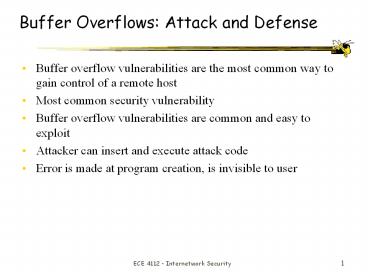Buffer Overflows: Attack and Defense - PowerPoint PPT Presentation
1 / 16
Title:
Buffer Overflows: Attack and Defense
Description:
Buffer overflow vulnerabilities are the most common way to gain control of a remote host Most common security vulnerability – PowerPoint PPT presentation
Number of Views:172
Avg rating:3.0/5.0
Title: Buffer Overflows: Attack and Defense
1
Buffer Overflows Attack and Defense
- Buffer overflow vulnerabilities are the most
common way to gain control of a remote host - Most common security vulnerability
- Buffer overflow vulnerabilities are common and
easy to exploit - Attacker can insert and execute attack code
- Error is made at program creation, is invisible
to user
2
Definition Exploit
- An exploit is code that takes advantage of a bug
in other code - Exploits can cause
- Crash of machine and denial of service
- Crash of just the program that is running
- Exploits have two halves
- Injection vector uses the bug itself to get in
- Payload not related to the bug at all, can do
just about anything an attacker wants to do
3
Exploit Injection Vector
- Depends totally upon the operating system as well
as the target hardware platform - Content based injector inserts characters in the
data that result in the program doing a bad thing
but the process is still cognizant - Buffer Overflow based injector causes process to
lose cognizance by overflowing the stack,
overflowing the heap, causes an instruction
pointer to go to an attacker controlled value in
order to point to an attack controlled buffer
4
Exploit Payload
- Independent of Exploit Injection Vector
- Dependent upon hardware platform, operating
system - Much like a virus
- Can cause remote shell, can cause rootkit to be
installed, can cause worm or virus activity, can
cause a denial of service
5
Buffer Overflow Principle
- Overwrite parts of memory that are not intended
to be overwritten - Make process execute this overwritten memory
6
Computer Memory Usage
- Code Segment Assembly instructions processor
executes - Data segment Variables and buffer
- Stack Segment - Store data to pass to functions
and storage for function variables
7
Computer Memory Usage
- Local Variables
Attack Code
String fills This way
Stack fills this way
Return Address
Local Variables
Buffer
8
Example Code
- void function(char str)
- char buffer16
- strcpy(buffer,str)
- void main()
- char large_string256
- int i
- for( i 0 i lt 255 i)
- large_stringi 'A'
- function(large_string)
- (Source Smashing the Stack)
9
Fundamental Concept
- By overwriting the return address with a value
that points to attack code, can cause attack code
to execute!
10
Attacker Goals
- To put or to use opportunistic code into
programs address space - Cause the execution of the program to jump to the
opportunistic code
11
Putting or Using Opportunistic code
- Insert the opportunistic code by string input
to program which is written to buffer - Use opportunistic code that already exists and
executes functions like exec(argument) where one
can pass the argument /bin/sh to cause
exec(/bin/sh)
12
How To Get The Program to Jump
- Corrupt the return address stored on the stack
- Most common technique
- Give a program a large string that both overflows
the buffer to overwrite the return address and to
put the attack code into program memory
13
Defense one
- Correct the source code in the programs
- Check the source code for fgets, gets, getws,
memcpy, memmove, scanf, sprintf, strcat, strncpy
where the length of the arguments are not checked - Use fault injection tools and/or static analysis
tools
14
Defense 2
- Make the data segment of the victim program
address space non-executable - Kernel patches exist to do this
- almost no programs have code in the stack
segment
15
Defense 3
- Array bounds checking all reads and writes need
to be checked to make sure they are within range - If arrays cannot be overwritten, then no buffer
overflow exploits - Hard to do this in compilers
16
Defense 4
- Code Pointer Integrity Checking check to see if
a return value has been corrupted before using it - Example is StackGuard which puts a canary word
next to the return address in the stack - (Source Buffer Overflows Attacks and Defenses
for the Vulnerability of the Decade
http//www.immunix.org/StackGuard/discex00.pdf)

